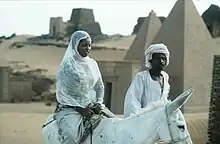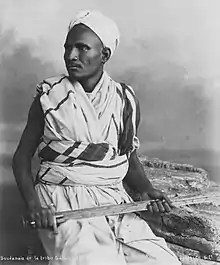Clothing in Sudan
Most Sudanese wear either traditional or western attire. A traditional garb widely worn by Sudanese men is the jalabiya, which is a loose-fitting, long-sleeved, collarless ankle-length garment also common to Egypt. The jalabiya is often accompanied by a large turban and a scarf, and the garment may be white, coloured, striped, and made of fabric varying in thickness, depending on the season of the year and personal preferences.[1]
.jpeg.webp)
The most common dress for Sudanese women is the thobe or thawb, pronounced tobe in Sudanese dialect. The thobe is a white or colourful long, one-piece cloth that women wrap around their inner garments, usually covering their head and hair.
Due to a 1991 penal code (Public Order Law), women were not allowed to wear trousers in public, because it was interpreted as an "obscene outfit". The punishment for wearing trousers could be up to 40 lashes, but after being found guilty in 2009, one woman was fined the equivalent of 200 U.S. dollars instead.[2][3]
Traditional clothing
Women
Sudan is a patriarchal society, in which women are generally accorded a lesser status than men. Due to a 1991 penal code (Public Order Law), women were not allowed to wear trousers in public, because it was interpreted as an "obscene outfit". The punishment for wearing trousers could be up to 40 lashes, but after being found guilty in 2009, one woman was fined the equivalent of 200 U.S. dollars instead.[2][3] In some parts of Sudan, there may be restrictions on attire for women, such as wearing pants or trousers, and non-compliance with these norms can lead to legal consequences.[4]
In terms of clothing, Sudanese women often wear the "Chadur," an extended piece of fabric that covers the entire body, including the head. The Chadur is typically worn as an outer coat, and it is accompanied by the "Tob" and the "Hijab." The Tob is a head covering, and the Hijab is a modest dress code followed by many Muslim women.[5] The clothing choices and social roles of women in Sudan are influenced by cultural norms and religious traditions. One traditional garment worn by Sudanese women is the "Toob," a long, colourful fabric wrap typically worn over a dress or shirt and a skirt. In the past, the Toob was worn by all Sudanese women, but modern preferences have shifted towards more contemporary clothing styles.[6]
Men
Another traditional attire for men is the "Jalabiya," a long white dress with various tribal variations and accompanying details. The Jalabiya has remained a popular fashion choice for Sudanese men across different tribes.[6]
Different regions within Sudan showcase unique fashion influences. In the Nubian region, clothing reflects the remnants of the great Kush civilization with its bright colors and playful designs. Eastern Sudanese men wear a longer Jalabiya accompanied by loose pants and vests, while western Sudan exhibits a mix of tribal and foreign influences, resulting in modern designs and African fabric patterns.[6]
Wearing Jibba, Taqiyah (cap), and Markoob is common.
The "markoub" is one of the most important features that make up the Sudanese identity, in addition to the white turban, jalabiya, waistcoat, top and pants, and with their integration they represent the Sudanese national dress. In the past, there was a boat for women, but it has now disappeared. The boat is made by hand in Sudan and varies in its shapes and sizes, including the boat of El Fasher and made in the city of El Fasher in western Sudan, the boat of Jenny and the boat of Al Jazeera Aba . The price, the skin of cows, sheep, and even crocodiles, and the Sudanese love to wear it during the two Eid prayers, and it is one of the symbols of Sudanese culture and the admiration of many Sudanese tourists.[7]
Kids
Kids' clothing in Sudan is heavily influenced by a combination of cultural, religious, and regional factors. Traditional attire for Sudanese children is deeply rooted in the country's Islamic heritage, with a strong emphasis on modesty, particularly in accordance with Islamic principles.[8]
Islamic values play a significant role in shaping children's clothing choices. Both boys and girls are encouraged to wear garments that cover their arms and legs, reflecting the importance of modesty in Islamic culture. For girls, this often entails wearing headscarves, especially as they reach adolescence.[8] Traditional Sudanese clothing, such as the "jalabiya," is a common choice for children. The jellabiya is a loose-fitting, long-sleeved, ankle-length garment, known for its comfort and suitability in Sudan's warm climate.[8]
Bright and vibrant colours are prevalent in Sudanese children's attire, and natural fabrics like cotton are favoured for their breathability and comfort, which is essential given Sudan's hot weather conditions. Accessories such as bracelets, necklaces, and rings are worn by Sudanese children, although these adornments are typically modest and simple in design. During special occasions and celebrations like Eid, Sudanese children adorn themselves in their finest clothing, often featuring more elaborate and colourful outfits, aligning with the festive spirit of these events.[9]
Footwear choices for children vary depending on whether they live in urban or rural areas. Urban children are more likely to wear modern shoes like sneakers, while those in rural areas may opt for traditional sandals or even go barefoot, reflecting the influence of regional factors on attire choices.
Jewellery

Sudanese jewellery has its origins trace back to ancient times, with archaeological excavations unearthing exquisite pieces made from materials such as gold, silver, and semi-precious stones. These artefacts provide a glimpse into the craftsmanship of ancient Sudanese civilizations. One notable influence on Sudanese jewellery is the Nubian civilization, renowned for its intricate gold ornaments.[10][11] Many of these treasures have been discovered in tombs, underlining their importance in Nubian burial traditions.[12]
Sudanese jewellery holds profound cultural significance and is often used to mark significant life events like weddings and ceremonies. The design and materials used can vary widely based on the ethnic group and regional customs within Sudan. Craftsmen employ a variety of materials, including gold, silver, beads, as well as natural elements like shells and bones. Traditional techniques like filigree, cloisonné, and beading have been passed down through generations.[13]
In modern Sudan, jewellery making remains a thriving art form. Contemporary Sudanese artists and designers blend traditional techniques with new styles and ideas, keeping Sudanese jewellery vibrant and relevant. Economic factors have also played a role in jewellery production, with artisans often relying on this craft for both their livelihood and the preservation of cultural heritage during challenging times.
Contemporary clothing

In recent times, Sudan has experienced various influences on its fashion sense, including Islamic colonization and the introduction of modest fashion, hijabs, abayas, and niqāb. These influences have shaped the modern Sudanese fashion landscape, merging traditional elements with contemporary styles.[6]
Textile industry
Sudan's fashion industry is evolving, and there is a growing interest in supporting local designers. Sudanese designers are emerging with brands like Amna's Wardrobe, offering elegant and modest clothing for special occasions.[14]
It is important to note that Sudan's fashion history is intertwined with its textile industry. The country has a long-standing relationship with textiles, and the establishment of modern textile factories using locally produced cotton dates back to 1945.[15] This highlights the potential for further growth and development in Sudan's fashion scene.
Significance of clothing
Sudan is a patriarchal society, in which women are generally accorded a lesser status than men. However, traditional clothing is still valued by many Sudanese as a symbol of their cultural heritage. Many Sudanese feel that by wearing traditional clothing, they can show their respect for their country and its people. They believe that traditional clothing is not only a reflection of their history but also a representation of their identity.[16] The clothing choices and social roles of women in Sudan are influenced by cultural norms and religious traditions.[4]
References
- Hansen, Andreas; Obling, Karen (2013-03-27). "Fashion on the streets of Darfur". The Guardian. ISSN 0261-3077. Retrieved 2023-09-24.
- Ross, Oakland (6 September 2009). "Woman faces 40 lashes for wearing trousers". The Toronto Star.
- Gettleman, Jeffrey; Arafat, Waleed (8 September 2009). "Sudan Court Fines Woman for Wearing Trousers". The New York Times.
- "What Types of Clothes Do They Wear in Sudan?". Our Everyday Life. Retrieved 2023-05-16.
- Colgrove, Debbie (2023-01-28). "Traditional Clothing Of Sudan". AkoTaq. Retrieved 2023-05-16.
- karim (2021-11-21). "Sudanese Traditional Clothing –". Retrieved 2023-05-16.
- "صناعة "المركوب" السوداني مهدّدة بالدخلاء والأحذية الصناعية". 2023-03-25. Archived from the original on 2023-03-25. Retrieved 2023-05-23.
- "Sudan". Australian Government.
- "Clothing-- a Matter of Place and Time in Sudan | Navigators". Carolina Navigators. 2012-09-18. Retrieved 2023-09-30.
- "The History of African Heritage Jewelry". Google Arts & Culture. Retrieved 2023-09-30.
- "Sudan, 1–500 A.D. | Chronology | Heilbrunn Timeline of Art History | The Metropolitan Museum of Art". The Met’s Heilbrunn Timeline of Art History. Retrieved 2023-09-30.
- Newsroom, Archaeology (2019-06-24). "Nubian Gold: Ancient Jewelry from Sudan and Egypt". Archaeology Wiki. Retrieved 2023-09-30.
- ""A Necklace of Shells from Distant Seas…"". Women's literacy in Sudan. 2020-02-01. Retrieved 2023-09-30.
- Khartoum, Lovin (2022-06-19). "5 Sudanese Fashion Designers That We Absolutely Love". Lovin Khartoum. Retrieved 2023-05-16.
- Hidayah, Saif. "Sudan, a Nation with "Great Resources and Potential"". Fashion Trust Arabia. Retrieved 2023-05-16.
- karim (2021-11-21). "Sudanese Traditional Clothing –". Retrieved 2023-05-16.
_(cropped).jpg.webp)
.jpg.webp)

